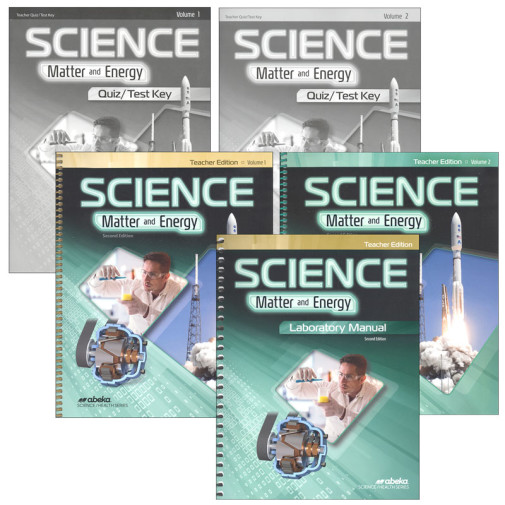We use cookies to make your experience better. To comply with the new e-Privacy directive, we need to ask for your consent to set the cookies. Learn more.
Physical Science Parent Kit - Revised
This Parent Kit includes the print resources for one teaching parent. Total contents include the Science: Matter & Energy Teacher's Edition Volume 1, Science: Matter & Energy Teacher's Edition Volume 2, Science: Matter & Energy Lab Manual Teacher Guide, Science: Matter & Energy Quiz & Test Key Volume 1-Revised, and Science: Matter & Energy Quiz & Test Key Volume 2-Revised. Recently revised, Science Matter and Energy offers reorganized and expanded content that includes a greater focus on scientific reasoning and engineering design, while maintaining a worldview that rejects evolution. The text material builds a foundation for upper-level chemistry and physics. The revised edition is not compatible with the previous edition.
Beginning with a look into the scientific method, scientific reasoning, and engineering design, students are then introduced to matter and energy. Subsequent topics covered are motion and forces, fluid mechanics, energy, heat, waves and sound, electricity and magnetism, electronics, foundations of chemistry, molecules, chemical reactions and thermodynamics, acids and bases, and organic and biochemistry. The book concludes with a section on creation and evolution. Lessons will take about 50 minutes per day, with some students needing more time.
Teach your child with ease and confidence using the Physical Science Parent Kit. Save time by purchasing the kit compared to purchasing each item separately. The 4 items included in this kit will give you 170 days of easy-to-use lesson plans, answer keys for the textbook and assessments for Science: Matter and Energy. Combine with the Physical Science Child Kit (sold separately) to teach science from a biblical worldview.
Recently revised, Science Matter and Energy offers reorganized and expanded content that includes a greater focus on scientific reasoning and engineering design, while maintaining a worldview that rejects evolution. The text material builds a foundation for upper-level chemistry and physics. The revised edition is not compatible with the previous edition.
Beginning with a look into the scientific method, scientific reasoning, and engineering design, students are then introduced to matter and energy. Subsequent topics covered are motion and forces, fluid mechanics, energy, heat, waves and sound, electricity and magnetism, electronics, foundations of chemistry, molecules, chemical reactions and thermodynamics, acids and bases, and organic and biochemistry. The book concludes with a section on creation and evolution. Lessons will take about 50 minutes per day, with some students needing more time.
The softcover Student Textbook provides textual readings, section reviews with application questions, and chapter reviews. Space to record answers is not included, so students will need a separate notebook. Feature boxes called A Closer Look highlight God's design in science or provide additional information and application of the lesson. Numerous graphics and colorful illustrations appear throughout the text to aid student understanding.
Spiral-bound, the Teacher Edition is divided into two volumes to better prepare you to teach teens successfully. Volume 1 covers chapters 1-8 and Volume 2 covers chapters 9-16. Each volume includes reduced student book pages, teaching tips, suggested lessons plans, writing prompts, topic demonstrations and answers to the text questions. STEM and biblical worldview topics are integrated. An Answer Key is available separately for those wishing to quickly check student answers.
Additional resources include the Lab Manual and the two-volume Quiz and Test Book. Answers are not included; each book has a separate teacher guide or answer key.
The Lab Manual provides 29 experiments plus an appendix with optional labs covering data recording investigations, engineering designs and more. Each experiment begins with an introduction, equipment and supply lists, step-by-step instructions, and a report sheet to complete. You will need to provide numerous items including a lab coat/apron, safety glasses/goggles, scale balance, graduated cylinder, digital scale (kg), measuring cups with ml measurements, beakers, petri dishes, test tubes, spring scale, copper sulfate, glycerin, sodium hydroxide, filter paper, a Bunsen burner, bar magnets, etc. You may be able to modify some of the activities to make them manageable in a homeschool setting.
The Lab Manual Teacher Guide includes the teaching notes for each lab activity, plus the student lab pages with answers for the report sheets and discussion questions. Lab procedures, grading suggestions and supply lists are also included.
Test and Quiz Book Volume 1 covers the first semester (chapters 1-8) and Volume 2 covers the second semester (chapters 9-16). Sold separately, the Answer Keys (one per volume) include answers, as well as suggestions for essay questions. It also includes a grading scale for each test and quiz. Student and teacher resources are not reproducible.
Student and Parent Kits are also available with the print resources for one student and the teaching parent respectively. ~Deanne

